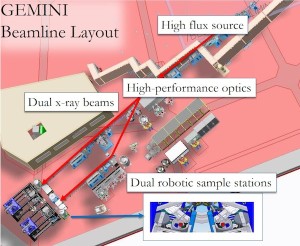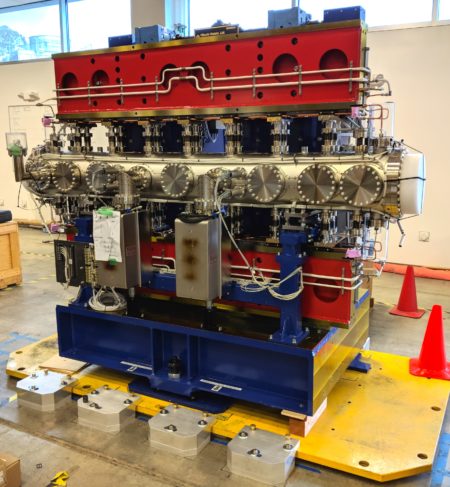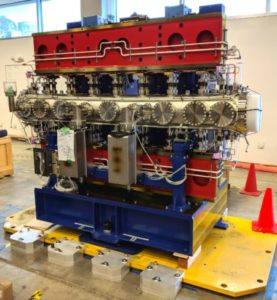A critical component of the planned state-of-the-art macromolecular crystallography beamline Gemini has arrived at the Lab. The specially-designed in-vacuum undulator insertion device will yield higher photon flux compared to the Advanced Light Source’s superbend magnet and wiggler sources, bringing solutions to some of the most challenging projects in structural biology within reach.
Undulators employ periodic arrays of permanent magnets to oscillate an electron beam as it passes between them. Each wiggle produces photons; the cumulative product of dozens or even hundreds of periodic wiggles is an intense beam of x-ray light. Dubbed Leda in reference to the Greek myth in which a Spartan queen seduced by Zeus (in the guise of a swan) begets twins Castor and Pollux, the device arrived in late April and is currently undergoing testing of the magnets to be certain that no damage occurred during its voyage via ship from Japan.
 With more than 1,000 neodymium-iron-boron permanent magnets inside its vacuum chamber, Leda has a 15 mm period, a 4.3 mm minimum operational gap, and is designed to generate photons between 5–19 keV. It has the capability to support twin branchlines within one hutch—the origin of the beamline’s name of Gemini—and both endstations will be accessible by a single robotic sample mounter, which is being designed now and will be installed in December. Leda will be installed during the January 2019 shutdown.
With more than 1,000 neodymium-iron-boron permanent magnets inside its vacuum chamber, Leda has a 15 mm period, a 4.3 mm minimum operational gap, and is designed to generate photons between 5–19 keV. It has the capability to support twin branchlines within one hutch—the origin of the beamline’s name of Gemini—and both endstations will be accessible by a single robotic sample mounter, which is being designed now and will be installed in December. Leda will be installed during the January 2019 shutdown.
The Gemini beamline was designed by ALS Staff Scientist Simon Morton and is primarily funded by the Howard Hughes Medical Institute. It will be operated by the Berkeley Center for Structural Biology under the leadership of Corie Ralston, the center’s head and a staff scientist in Biosciences’ Molecular Biophysics and Integrated Bioimaging (MBIB) Division.
Read more about Leda from the ALS.





